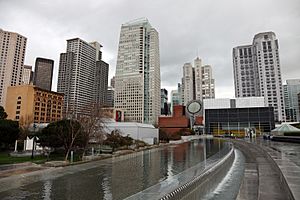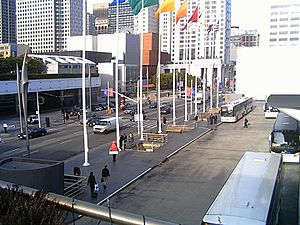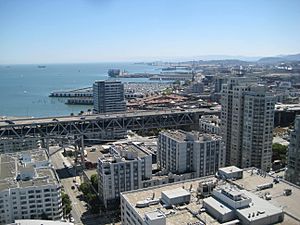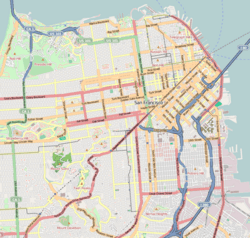South of Market, San Francisco facts for kids
Quick facts for kids
SoMa
|
|
|---|---|

Buildings in the South of Market neighborhood
|
|
| Nickname(s):
SoMa
|
|
| Country | United States |
| State | California |
| City-county | San Francisco |
| Area | |
| • Total | 0.635 sq mi (1.64 km2) |
| • Land | 0.635 sq mi (1.64 km2) |
| Population | |
| • Total | 11,457 |
| • Density | 18,043/sq mi (6,966/km2) |
| Time zone | UTC−8 (Pacific) |
| • Summer (DST) | UTC−7 (PDT) |
| ZIP Code |
94103
|
| Area codes | 415/628 |
South of Market (often called SoMa) is a lively neighborhood in San Francisco, California. It is located just south of Market Street. SoMa is known for its many museums, the offices of big software and internet companies, and the large Moscone Conference Center.
Contents
What is SoMa and where is it located?
SoMa is a large area in San Francisco. Its borders are Market Street to the northwest and the San Francisco Bay to the northeast. To the southeast, you'll find Mission Creek. To the southwest, the borders are Division Street, 13th Street, and U.S. Route 101.
The streets in SoMa are different from other parts of San Francisco. They run parallel and perpendicular to Market Street. This area includes smaller neighborhoods like South Park, Yerba Buena, and South Beach. It also overlaps with Mission Bay and the Mission District.
How did SoMa get its name?
The name "South of Market" simply means it's the area south of Market Street. People often shorten it to "SoMa." This nickname might come from "SoHo" in New York City, which means "South of Houston Street."
Before it was called South of Market, some people called it "South of the Slot." This name came from the slots in the street where cable cars used to grip their cables along Market Street. Even though the cable cars are gone from Market Street, some older residents still use this name.
Since 1847, the official name for this area in city records has been the "100 Vara Survey" or "100 Vara District." A "vara" is an old Spanish unit of measurement, about 33 inches (84 cm). The name came from the size of the land lots, which were 100 by 100 varas.
A brief history of SoMa
In 1847, a leader of San Francisco named Washington A. Bartlett asked a surveyor, Jasper O'Farrell, to expand the city. O'Farrell designed the new streets in this area to run differently from the older parts of the city. He also made the new blocks much larger. He created Market Street as a "grand promenade" to connect the old city with this new area. The older part of San Francisco is known as "50 Vara," and SoMa is known as "100 Vara."
Early development and changes
In the mid-1800s, SoMa grew as a new community. It had homes and a business area near 2nd and 3rd streets. Industrial areas also started to appear near the waterfront. At first, wealthy families lived in Rincon Hill, and upper-middle-class families lived in South Park.
By the early 1900s, more factories and industries moved in because of the nearby docks. This, along with new cable car lines, caused the wealthy families to move to other neighborhoods like Nob Hill. SoMa then became a place for working-class families, many of whom were recent immigrants. It had factories, power stations, and small hotels.
The 1906 earthquake and rebuilding
The terrible 1906 earthquake completely destroyed SoMa. Many people died in this area. After the earthquake, the neighborhood was rebuilt with wider streets. The focus was on developing light and heavy industries.
In the 1930s, the construction of the Bay Bridge and U.S. Route 101 caused many parts of SoMa to be torn down. This included most of the original Rincon Hill.
Transportation in the past
From the late 1800s to the mid-1900s, several streetcar lines served the South of Market area. These streetcars helped people travel around the neighborhood and to other parts of the city.
Later changes and modern growth
In the 1940s and 1950s, SoMa was home to warehouses and light industries. Many working people lived in hotels and older Victorian buildings.
In the 1960s, a new group of people moved into the area. This was partly due to changes along the Embarcadero waterfront. From 1962 to 1982, a community grew and became active in SoMa, especially along Folsom Street. This area was good for community gatherings because it had many warehouses that were empty at night.
In 1984, as some community spaces were closing, a group of activists started the Folsom Street Fair. This event helped the community be seen and raised money for important services.
Plans for rebuilding SoMa began in 1953. These plans started to happen in the late 1970s and early 1980s with the building of the Moscone Center. This large conference center takes up three city blocks and hosts many big events. Moscone South opened in 1981, Moscone North in 1992, and Moscone West in 2003.
When the San Francisco Museum of Modern Art opened in 1995, the area around Mission and Howard Streets became a center for museums and performance spaces.
In the late 1990s, SoMa became a hub for technology companies during the "dot-com boom." Its central location and available spaces were perfect for new offices and homes.
A big change for the neighborhood started in the 2000s with the Transbay Terminal Replacement Project. This project, which began in 2010, aims to create a modern transportation hub. Also, new tall residential buildings like One Rincon Hill, 300 Spear Street, and Millennium Tower are changing the San Francisco skyline.



What is SoMa like today?
Today, SoMa is a mix of many things. You'll find warehouses, auto repair shops, nightclubs, art spaces, and modern loft apartments. There are also many furniture stores, condominiums, and technology companies.
A large children's park was built on top of Moscone South. This park has a big play area, an ice skating rink, a bowling alley, a restaurant, the Children's Creativity Museum, and a restored carousel from an old amusement park. This park and the Children's Creativity Museum are connected to the Yerba Buena Gardens by a footbridge.
Businesses in SoMa
Many important software and technology companies have their main offices or branches in SoMa. Some of these include Salesforce, Dropbox, Pinterest, Uber, Airbnb, and Yelp. The area also has some of San Francisco's few big-box stores.
Other attractions
The local Academy of Art University owns several buildings in SoMa. These buildings are used for classes and administrative purposes.
Culture and events
Cultural centers and museums
SoMa is home to many of San Francisco's museums and art spaces. These include the San Francisco Museum of Modern Art (SFMOMA), the Yerba Buena Center for the Arts, the Museum of the African Diaspora, and the Contemporary Jewish Museum. The Old Mint, a historic building that was once a mint, was restored and reopened to the public in 2012.
SOMArts is a cultural center owned by the City and County of San Francisco. It is located on Brannan Street. Many small theater companies also have their homes in SoMa, offering a variety of performances.
Events in SoMa
SoMa hosts several popular events throughout the year. The Folsom Street Fair is held on Folsom Street. The smaller Up Your Alley Fair (also called the Dore Alley Fair) happens in late July. The annual How Weird Street Faire is held in early May, featuring dancing and costumes.
Several Filipino cultural events also take place in SoMa. These include the Filipino American History Month Celebration in October and the Pistahan Parade and Festival in August. Undiscovered SF is a monthly event that helps promote Filipino businesses and culture in the area.
Cultural Districts
Leather and LGBTQ Cultural District
In 2018, the Leather and LGBTQ Cultural District was created in SoMa. This district helps preserve the history and culture of these communities in the area. It includes the San Francisco South of Market Leather History Alley, which opened in 2017.
SoMa Pilipinas
In April 2016, the San Francisco Board of Supervisors officially recognized the SOMA Pilipinas Filipino Cultural Heritage District. This district celebrates the history and culture of Filipino Americans in the area. The city recognized Tagalog as its third official language in 2014. Many Filipinos live in the South of Market District. Within the SOMA Pilipinas borders, you can find streets named after important Filipino historical figures, like Rizal and Lapu-Lapu.
Images for kids
-
The Moscone Center, a major conference venue in SoMa.
-
The South Beach section of SoMa, with AT&T Park in the background.
-
South Park, a green space in the SoMa District.
See also
 In Spanish: South of Market para niños
In Spanish: South of Market para niños





